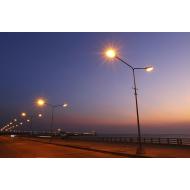Wireless point-to-point management systems represent a revolution in the concept of outdoor lighting. The infrastructure of public lighting luminaires is omnipresent, evenly distributed and well connected to the mains, i.e. it meets the basic requirements needed to house a data procurement and transmission network without additional adaptation costs. Each outdoor lighting luminaire can be converted into a data server by fitting it with programmable state-of-the-art drivers, different types of sensors, and wireless connectivity and communications, to create an operating system for smart lighting management and the development of new applications. Thus, outdoor lighting infrastructure can provide a new service: on top of offering sources of light, luminaires can be turned into data nodes within the Internet of Things infrastructure.
The Internet of Things (IoT) is the capability that technology gives us to add intelligence and communications to objects in our daily life – the ability to monitor and handle objects in the various fields in which human activity takes place, from production plants and cities to health and leisure, that enables us to make decisions in order to create optimised, efficient environments, processes and schedules, with the ultimate aim of improving our quality of life.
Therefore, any outdoor lighting management scheme should be defined, designed and structured on the basis of that essential premise: in addition to providing efficient light management, it should go even further to transform and boost the creation of value using the lighting system’s infrastructure.
So, whatever management system is proposed, it must provide data for effective lighting control, but must also have the ability to provide programmable real-time lighting profiles adapted to the environment and its characteristics as well as information from external data sources, such as local events or weather forecasts. In that way, the lighting system creates areas of security and convenience that improve the user’s experience and quality of life. Naturally, such a system should also seek to further the sustainability of the infrastructure, to optimise energy consumption, and to curb costs, while also providing information relevant to the system’s preventive maintenance. That is achieved by measuring parameters and analysing statistics, enabling diagnostic procedures and testing, effective management of alarms and events, and, above all, by providing for a simple installation process based on concepts such as self-configuration and dynamic adaptation, which reduces the cost and complexity.
In other words, wireless point-to-point public lighting management systems should be designed so that converting the luminaire into a node within the Internet of Things and likewise, incorporating additional sensors (environmental, noise, movement, vibration, and a long list of others) is made easier. That will enable them to be integrated into horizontal Smart City management platforms and facilitate the installation of communications or other service infrastructures such as parking management, number of pedestrians and vehicles, or citizen information systems.
As is to be expected, the development of a management system of this nature poses a number of challenges that it is essential to address successfully. It calls for careful assessment and choice of suitable technology within an environment of dynamic standardisation, in which new solutions, alliances and proposals emerge and disappear at high speed and compete among each other. It calls for criteria, regulations and specifications in the lighting industry to be integrated and harmonised with other industry communication systems and the Internet of Things. It inevitably needs to be accepted by the end user, taking into account measures and guarantees of security and privacy. And it means moving to a business model based not exclusively on products but also on the provision of services with the highest standards of reliability and quality.
Juan José González, Smart Systems Division Manager



